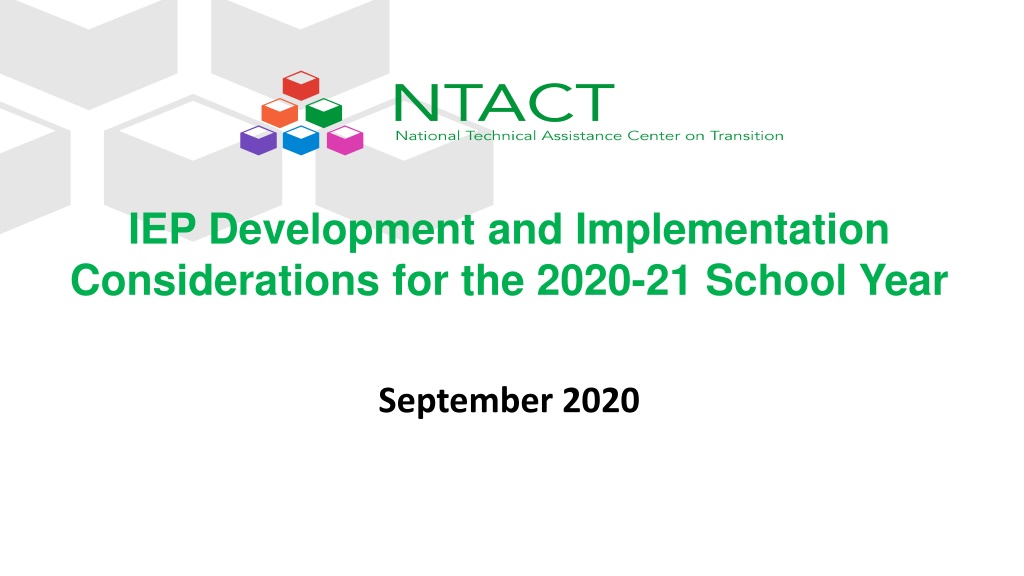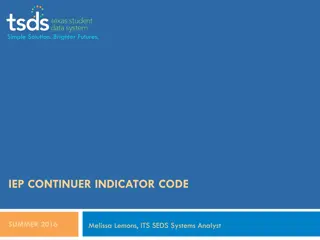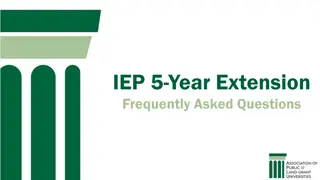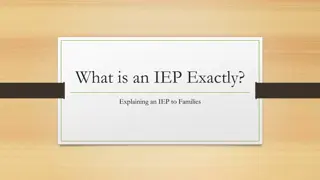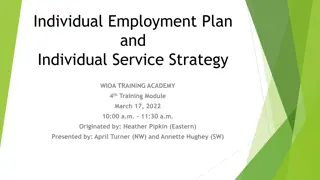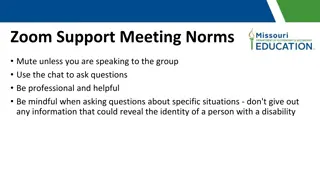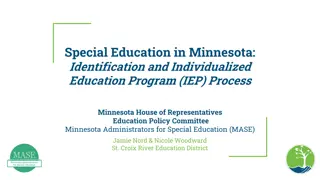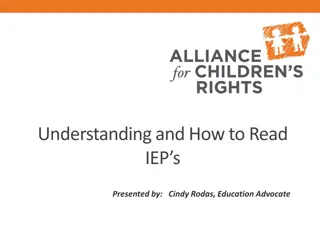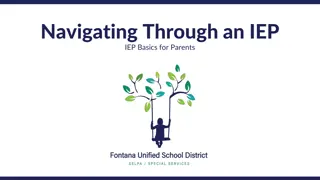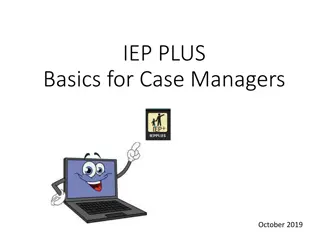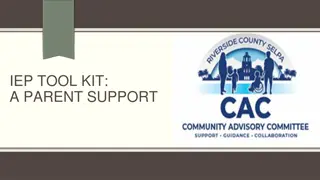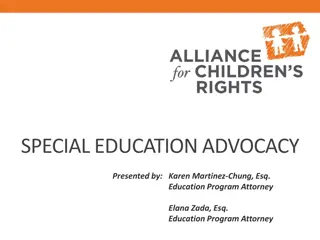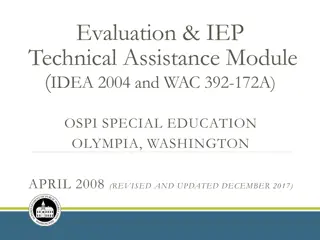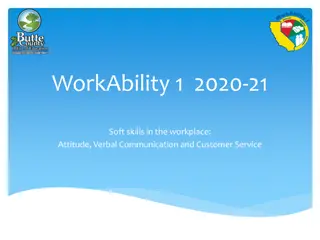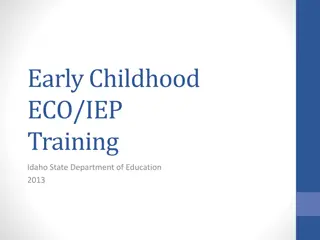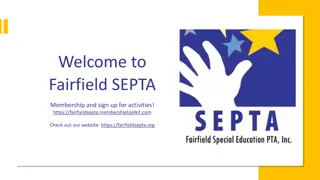IEP Development and Implementation Considerations for 2020-21 School Year
Explore strategies and reflections for developing and implementing Individualized Education Programs (IEPs) for the 2020-21 school year. Consider delivery of instruction, resources, and transition-related activities to support students effectively in challenging times.
Download Presentation

Please find below an Image/Link to download the presentation.
The content on the website is provided AS IS for your information and personal use only. It may not be sold, licensed, or shared on other websites without obtaining consent from the author. Download presentation by click this link. If you encounter any issues during the download, it is possible that the publisher has removed the file from their server.
E N D
Presentation Transcript
IEP Development and Implementation Considerations for the 2020-21 School Year September 2020
How To View This Presentation In a group as part of a school or department Individually With and IEP available and using the stop/start feature of the recording play back
Agenda Strategies and Reflections for the 2020-21 School Year 2020-21 - IEP Considerations Present Levels Measurable Annual Goals Transition Services 3
Strategies and Reflections for the 2020-21 School Year 4
Considerations for Delivering Instruction Have an assigned school staff communicate weekly with families and students (social workers, counselors, transition coordinators, teachers) Guide families to set up a daily/ weekly schedule that works for them Review goals, lessons plans, making sure they are accessing information Brainstorm household items/resources/activities that could enhance instruction
Considerations for Delivering Instruction Provide resources Share materials teacher or school webpages, email, hard copies mailed home Think about what you use in the classroom, visuals, assistive technology. Videos live group and 1:1 chats, recorded videos on lessons (keep to < 15 minutes) Subscription access lots are free, may be able to provide passcodes or set up link through school s webpage
Transition Related Activities Workplace Readiness Explore-work.com myFUTURE.com Career Skills to Pay the Bills Realityworks Curriculum Dr. Kit - Essential Skills Life skills Household chores (cleaning room, dishes, laundry, taking out garbage, setting table, inventorying household supplies); meal planning (grocery list, shopping, cooking); money skills; outside/yard maintenance; importance of good hygiene.
Transition Related Activities Job readiness/ exploration The Career Index Plus (TCI+) https://www.careeronestop.org/ExploreCareers/explore-careers.aspx https://www.mynextmove.org Road Trip Nation - YouTube Channel Dr. Kit Career Videos Virginia Career View * Contact your local Vocational Rehabilitation office/ Counselor about remote and coordinated Pre-Employment Transition Services (Pre-ETS)
Transition Related Activities Transition Assessments Student and parent transition surveys many on-line assessments of self- determination, career interests and strengths, etc. Transition Assessment Matrix www.transitioncoalition.org Personal Preference Indicators: A Guide for Planning Life Course Framework I m Determined.org Social Skills - practice using various media to keep in contact with family and friends phone calls, text, FaceTime, social media (safely), Zoom, etc.
Transition Related Activities Even though this is a challenging time, this can be an opportune time for in-depth, person-centered transition planning with students, their families, and other IEP team members. Discuss what a meaningful day / week will look like Work, learn, play, and healthy living Discuss what supports the student/family will need post-school Discover agency linkages the student/family may need
Reminders Ultimately take care of yourself and your family These are difficult times - take time to breathe and think about doing what is appropriate and reasonable for your students and/or sons and daughters and yourself given your time and environment Engage the youth as much as possible in decision making Keep track of what you are doing (documentation) Provide a routine or schedule for learning When possible, coordinate with other school/agency personnel 13
IEP Considerations for 2020-21 School Year An IEP is a legally binding document updated annually that describes an offer of FAPE to a student with a disability It may be necessary to convene a meeting to update the IEP with a temporary plan that outlines the extent to which IEP services and accommodations must be delivered differently due to emergency health and safety restrictions related to COVID-19. Indicate the instructional model the student will participate in o At home learning packets (paper based hard copy curriculum) o At home learning - Online/virtual learning o Face to face learning for part of the week with at home assignments for the days the students are not in physical attendance
Over-all considerations for the IEP All decisions regarding the completion and/or updates to the IEP should be made by the IEP team on an individual case-by-case basis. Present Levels of Academic Achievement and Functional Performance (PLAAFP)
PLAAFP It is impossible to write clear and measurable annual goals if you don t haveclear and measurable present levels of academic achievement and functional performance. 16
PLAAFP Reflects and indicates the instructional model the student will participate Succinctly describes the student Describe instructional level versus grade level expectations Refer to summative, formative, benchmark assessments (and diagnostic as appropriate) Directly relate to assessments and evaluation information Provide information on student s rate of progress Guide the development of IEP goals and objectives
Present Levels Must Be data driven-precise, measurable and observable. Provide a starting point (baseline) for development of measurable annual goals. Address each post-secondary transition goal area Be relevant useful and understandable Incorporate information from all team members Describe effect of disability on performance Identify strengths and prioritize needs Guide development of other areas of the IEP
Address Each Bullet on the IEP Present levels of academic performance Present levels of functional performance Present levels related to current post-secondary transition goals (if student is 14, or younger if determined by the IEP team) Parental concerns for enhancing the education of the student How student s disability affects involvement and progress in general education curriculum Strengths Academic, developmental, and functional needs related to the student s disability
Before you write present levels Introduce the student with a succinct, clear statement that includes information such as Name, age, grade Disability School attending Indicates the instructional model the student will participate in learning for 2020-21 Addresses how learning took place from March June 2020 Anticipated year of graduation Type of program and services currently receiving Post-secondary goals including postsecondary education/training, employment, independent living
Present Levels of Academic Achievement Address by skill area: Reading, Writing, Math, etc. Include assessment data: Describe instructional level as compared to grade level expectations Provide information on student s rate of progress
Present Levels of Academic Achievement Observations, reports, grades, class participation, organizational skills, formative assessment Input from teachers is essential Effective specially designed instruction Strengths & areas of weakness or errors Guides the development of IEP goals and objectives How does the student s current performance relate to reaching his/her future goals? 22
Functional Behavior Assessment and behavior data Present levels of Functional Performance Social skills PT, OT, mobility Self help; Activities of Daily Living (ADL) Organizational skills Progress monitoring data specific to any related service goals 23
Present Levels of Functional Performance Recreation, community participation Relevant social and health information How does the functional performance relate to the student reaching his/her future goals? Summary of agency support 24
Present Levels of Functional Performance: Describing Behaviors Description should answer these questions: What specific type of behavior does the student exhibit? Approximately how frequently does this occur? What is happening or under what circumstances does the behavior typically occur? What is the consequence for the behavior? What is the perceived function of the behavior (result of FBA)? What does the student say about his/her behavior? 25
Present Levels Related to Current Postsecondary Transition Goals Name and date assessments used Describe results of assessments of interests & preferences Postsecondary Education Describe the student s goals for each of the three areas: Employment Independent Living 26
Present Levels Related to Current Postsecondary Transition Goals Remember that if any goal area is not needed, the present education levels must document WHY. Remember to address goals that appear to be unrealistic with additional assessment data. Post-secondary goals must be updated each year Include a statement regarding agency involvement appropriate to student s situation and age 27
Parental Concerns Include relevant parent information regarding student strengths and needs and/or specific parent concerns Include the parent transition survey information 28
How the students disability affects involvement and progress in the general education curriculum How does the information presented in the previous sections impact the student s ability to be successful in the curriculum? How might the disability affect the student s ability to be successful in his/her post-secondary goals?
Strengths Build upon the student s strengths Refer to assessment data Examples: Academic strengths Self determination/self advocacy Work related behaviors Communication or social interaction skills 30
Academic, developmental, and functional needs related to student s disability A prioritized list of the student s skill deficits that must be addressed in order to meet the student s post-secondary goals. For example, Sam needs to: Follow three-step verbal directions Develop coping skills to use in stressful situations Improve ability to decode longer words Use a digital watch or cell phone to estimate time Use cash to make simple purchases
Present Levels Academic skills Functional skills Skills related to post- secondary transition Parent Input How disability impacts involvement in general education curriculum STRENGTHS NEEDS
All needs must be met through: Measurable annual goals (MAG) Transition activities Specially designed instruction (SDI) Related service
Stop Think - Consider How do you see the PLAAFP impacted by: At home learning packets (paper based hard copy curriculum) At home learning - Online/virtual learning Face to face learning for part of the week with at home assignments for the days the students are not in physical attendance 34
Over-all considerations for the IEP All decisions regarding the completion and/or updates to the IEP should be made by the IEP team on an individual case-by-case basis. Measurable Annual Goals
Lets Review: Measurable Annual Goals Four required parts: 1. Condition 2. Student s Name 3. Clearly Defined Behavior 4. Performance Criteria Adapted from Strategies for Writing Better Goals and Short Term Objectives or Benchmarks by Benjamin Lignugaris/Kraft Nancy Marchand-Martella and Ronald Martella Sept/Oct 2001 Teaching Exceptional Children 36
Measurable Annual Goals 1. Condition Describes the situation in which the student will perform the behavior (e.g., accommodations, assistance provided prior to or during assessment) Describes material that will be used to evaluate the learning May describe the setting for evaluation Examples: During lunch breaks on the job Given picture checklists to follow .. Using graphic organizers for writing assignments Using grade level passages Given a two-step direction Given a grocery list and $20 Using the alarm feature on his cell phone 37
Measurable Annual Goals 2. Student Name Should not be a problem! Caution if using copy/paste Names Pronouns (she/he and him/her) 38
Measurable Annual Goals 3. Clearly Defined Behavior Use State Academic Standards as basis Describe the behavior in measurable, observable terms Ask yourself what will the student actually DO? Examples: Say, print, write, read orally, point to, solve Non-examples: Understand, know, recognize, behave, comprehend, improve 39
Measurable Annual Goals 4. Performance Criteria 3 Parts of the Performance Criteria: 1. Criterion Level How well- the level the student must demonstrate for mastery 2. Number of Times Needed to Demonstrate Mastery How consistently the student needs to perform the skill(s) before it s considered mastered 3. Evaluation Schedule How frequently the teacher plans to assess the skill HOW progress will be monitored 40
Example Language for Performance Criteria How Well? ___% of time ___% accuracy __ out of ___ times with _# correct with ___or fewer errors with __ out of __ points on rubric or checklist words/digits/ correct per minute with no more than ___ occurrences of with an ___or better on skill specific rating scale earning __% of possible points per day with x movement on a prompting hierarchy independently 41
Example Language for Performance Criteria Evaluation Schedule How Frequently will we monitor progress? Daily (seldom used for progress monitoring because instruction needs to occur between monitoring opportunities) 2 times per week Weekly Biweekly Tri-weekly Note: Quarterly is not often enough! Times to mastery How Consistently? 3 of 5 random trials 5 consecutive trials 4 out of 5 trials 42
Measurable Annual Goals at a Glance Name Condition Clearly Defined Behavior Performance Criteria Describe behavior in measurable, observable terms. Use action vebs. Describe the situation in which the student will perform the behavior. The level the student must demonstrate for mastery: Number of times needed to demonstrate mastery: Evaluation Schedule: How often? How consistently? What will s/he actually DO? How often will the student be assessed? Materials, settings, accommodations? How consistently will the student need to perform the skill(s) before considered mastered? Examples: Locate Name Point Separate Rank Choose How well? Examples: Examples: Given visual cues % of the time AND : What will be the method of evaluation? During lectures in math #times/# times Given active response checks With the # or % accuracy Remember--Academic Standards, Assessment Anchors, Big Ideas, Competencies from the Standards Aligned System (SAS) provide the content for goals. X or better on a rubric or checklist. 43
Examples When given a writing prompt John will demonstrate conventions of standard English by writing complex sentences with correct punctuation at 80% on 3 out of 4 trials At home learning packets (paper based hard copy curriculum) At home learning - Online/virtual learning Face to face learning for part of the week with at home assignments for the days the students are not in physical attendance 44
Examples Given a 4th grade level reading passage John will answer 10 who, what, where, when, or why questions with 80% accuracy on 3 out of 4 trials At home learning packets (paper based hard copy curriculum) At home learning - Online/virtual learning Face to face learning for part of the week with at home assignments for the days the students are not in physical attendance 45
Examples When given 10, 2 step word problems involving addition and subtraction John will draw a model or use manipulatives to solve the problems with 75% on 3 out of 4 trials At home learning packets (paper based hard copy curriculum) At home learning - Online/virtual learning Face to face learning for part of the week with at home assignments for the days the students are not in physical attendance 46
Examples With guidance and prompting from teacher/school staff, John will sit at his seat and remain on task until task completion with 3 out of 5 prompts for redirection At home learning packets (paper based hard copy curriculum) At home learning - Online/virtual learning Face to face learning for part of the week with at home assignments for the days the students are not in physical attendance 47
Examples With guidance and redirection from teachers and staff John will come to class on time with 3 or less prompts for all academic classes with 80% consistency for 4 out of 5 school days. At home learning packets (paper based hard copy curriculum) At home learning - Online/virtual learning Face to face learning for part of the week with at home assignments for the days the students are not in physical attendance 48
Discussion How do you see Measurable Annual Goals impacted by: At home learning packets (paper based hard copy curriculum) At home learning - Online/virtual learning Face to face learning for part of the week with at home assignments for the days the students are not in physical attendance 49
Over-all considerations for the IEP All decisions regarding the completion and/or updates to the IEP should be made by the IEP team on an individual case-by-case basis. Secondary Transition Courses of Study Statement of Needed Transition Services
